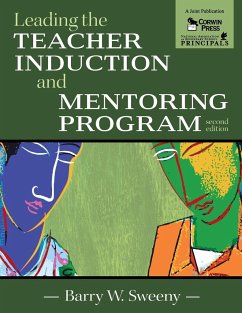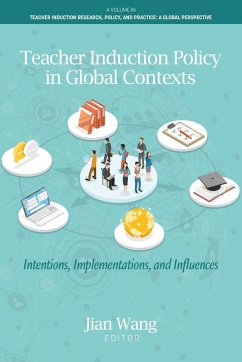Barry W. Sweeny
Leading the Teacher Induction and Mentoring Program
Barry W. Sweeny
Leading the Teacher Induction and Mentoring Program
- Broschiertes Buch
- Merkliste
- Auf die Merkliste
- Bewerten Bewerten
- Teilen
- Produkt teilen
- Produkterinnerung
- Produkterinnerung
Use these step-by-step strategies to develop and implement a proven program that links to districtwide goals and results in highly qualified teachers and increased student achievement.
Andere Kunden interessierten sich auch für
![Leading the Technology-Powered School Leading the Technology-Powered School]() Marilyn L. GradyLeading the Technology-Powered School33,99 €
Marilyn L. GradyLeading the Technology-Powered School33,99 €![Teacher Induction Policy in Global Contexts Teacher Induction Policy in Global Contexts]() Teacher Induction Policy in Global Contexts62,99 €
Teacher Induction Policy in Global Contexts62,99 €![Teacher Induction Policy in Global Contexts Teacher Induction Policy in Global Contexts]() Teacher Induction Policy in Global Contexts106,99 €
Teacher Induction Policy in Global Contexts106,99 €![Evidence-Based Strategies for Leading 21st Century Schools Evidence-Based Strategies for Leading 21st Century Schools]() Lynne SchrumEvidence-Based Strategies for Leading 21st Century Schools39,99 €
Lynne SchrumEvidence-Based Strategies for Leading 21st Century Schools39,99 €![Ray's Arithmetic, Second Book: Intellectual Arithmetic, by Induction and Analysis Ray's Arithmetic, Second Book: Intellectual Arithmetic, by Induction and Analysis]() Joseph RayRay's Arithmetic, Second Book: Intellectual Arithmetic, by Induction and Analysis35,99 €
Joseph RayRay's Arithmetic, Second Book: Intellectual Arithmetic, by Induction and Analysis35,99 €![Leading Schools Through and Beyond the Pandemic Leading Schools Through and Beyond the Pandemic]() Leading Schools Through and Beyond the Pandemic107,99 €
Leading Schools Through and Beyond the Pandemic107,99 €![Leading Schools Through and Beyond the Pandemic Leading Schools Through and Beyond the Pandemic]() Leading Schools Through and Beyond the Pandemic62,99 €
Leading Schools Through and Beyond the Pandemic62,99 €-
-
-
Use these step-by-step strategies to develop and implement a proven program that links to districtwide goals and results in highly qualified teachers and increased student achievement.
Hinweis: Dieser Artikel kann nur an eine deutsche Lieferadresse ausgeliefert werden.
Hinweis: Dieser Artikel kann nur an eine deutsche Lieferadresse ausgeliefert werden.
Produktdetails
- Produktdetails
- Verlag: Corwin
- 2. Auflage
- Seitenzahl: 298
- Erscheinungstermin: 1. August 2007
- Englisch
- Abmessung: 280mm x 216mm x 16mm
- Gewicht: 755g
- ISBN-13: 9781412944618
- ISBN-10: 1412944619
- Artikelnr.: 22777435
- Herstellerkennzeichnung
- Libri GmbH
- Europaallee 1
- 36244 Bad Hersfeld
- gpsr@libri.de
- Verlag: Corwin
- 2. Auflage
- Seitenzahl: 298
- Erscheinungstermin: 1. August 2007
- Englisch
- Abmessung: 280mm x 216mm x 16mm
- Gewicht: 755g
- ISBN-13: 9781412944618
- ISBN-10: 1412944619
- Artikelnr.: 22777435
- Herstellerkennzeichnung
- Libri GmbH
- Europaallee 1
- 36244 Bad Hersfeld
- gpsr@libri.de
Barry W. Sweeny is the president of Best Practice Resources, Inc. an independent educational consulting firm in Wheaton, Illinois. He has been a consultant, facilitator, trainer, and author, as well as a presenter and keynoter at educational conferences. Mr. Sweeny's specialty is the development of teacher mentoring and induction programs and practices that result in high quality instruction and increased student learning. Barry has trained thousands of mentors and administrators, and helped develop or improve hundreds of programs in school districts, professional associations and collaboratives, universities, regional agencies, community and governmental agencies, and businesses. His "High Impact" model of induction and mentoring is used all over the world for accomplishing the goals of supporting and guiding new teachers into the profession AND for creating programs that help districts accomplish their strategic initiatives. Barry is also known for his role in founding the ASCD Mentoring Leadership and Resource Network and is a Director Emeritus of the International Mentoring Association. In addition, Barry has worked in school improvement, peer coaching, staff development, and performance-based teaching, learning, and assessment. Previously, he was an award-winning classroom teacher for 22 years, a district staff developer and mentor program coordinator, and a program development manager at two regional offices of education.
List of Figures
Preface
Acknowledgments
About the Author
Introduction
Mentoring Questions Leaders Want Answered
Defining Mentoring, Induction, and Peer Coaching
The Increasing Importance of Mentoring and Induction
The Compelling Rationale for Mentoring and Induction
1. Getting Off to the Right Start
Differences Make All the Difference
Using a Model of Teacher Development to Guide Program and Practice
The Concerns-Based Adoption Model (CBAM)
Assessing and Using Data on New Teacher Needs
Three Concepts Essential for Program Success
The Big Picture: The High Impact Program Components
2. The Program Design Process
Design From the Destination
The First Step: Establish a Program Leadership Group
The Next Step: Identify a Program Coordinator
Roles of the Mentor Program Coordinator
The Sequence for Creating a Successful Program
Deciding the Sequence for Implementing Program Components
Defining Program Purposes, Goals, and Objectives
A Summary
3. Induction Structures for Effective New Teacher Development
Components for a High-Impact Induction Program
The Evolving Picture of Your Protégés
Using the CBAM to Design Induction
Designing an Effective Initial Orientation
Protégé Training
Protégé Observations of Expert Practitioners
Protégé Peer Support
Protégé Reflective Practice and the Professional Standards
Use of Professional Development Goals, Plans, and Portfolios
The Mentor in the Middle
Working Toward the Ideal Induction Program Model
4. Providing the Time for Effective Mentoring
Full- or Part-Time Mentoring?
Finding and Making Time for Mentoring
5. Designing Components of a High-Impact Mentoring Program
Roles and Tasks of the Ideal Mentor
Roles and Tasks of Protégés
Roles and Tasks of Site Administrators
Mentor Recruitment
Mentor Selection and Mentor-Protege Matching
How Does a Balanced Selection and Matching Process Work?
Matching Mentors and Protégés
Dealing With a Mentor-Protégé MISmatch
Mentor Support After Training
Mentoring of Mentors: Program Leader Support of Mentors
Mentor Incentives and Recognition
6. Designing a High-Impact Mentor Training
Who Should Lead Mentor Training?
What Are the Themes for High-Impact Mentor Training?
What Is the Sequence for Content and Activities in Mentor Training?
What Follow Up Support Is Needed to Ensure Mentor Implementation of
Training?
7. Evaluating, Improving, and Sustaining the Program
The Program Evaluation Learning Agenda
Using the Research Showing Induction's Impact on Results
Basic Evaluation Knowledge
Designing an Evaluation Process and Plan
Demonstrating Compelling Return on Investment From Induction
Other Strategies for Supporting and Sustaining the Program
Resources
I. Internet & Organization Resources for Mentoring
II. Mentor Training Activity: Practice in Identification of CBAM Stages of
Concern
III. Mentor Practice Scenarios: Ending Your Conversations
References
Index
Preface
Acknowledgments
About the Author
Introduction
Mentoring Questions Leaders Want Answered
Defining Mentoring, Induction, and Peer Coaching
The Increasing Importance of Mentoring and Induction
The Compelling Rationale for Mentoring and Induction
1. Getting Off to the Right Start
Differences Make All the Difference
Using a Model of Teacher Development to Guide Program and Practice
The Concerns-Based Adoption Model (CBAM)
Assessing and Using Data on New Teacher Needs
Three Concepts Essential for Program Success
The Big Picture: The High Impact Program Components
2. The Program Design Process
Design From the Destination
The First Step: Establish a Program Leadership Group
The Next Step: Identify a Program Coordinator
Roles of the Mentor Program Coordinator
The Sequence for Creating a Successful Program
Deciding the Sequence for Implementing Program Components
Defining Program Purposes, Goals, and Objectives
A Summary
3. Induction Structures for Effective New Teacher Development
Components for a High-Impact Induction Program
The Evolving Picture of Your Protégés
Using the CBAM to Design Induction
Designing an Effective Initial Orientation
Protégé Training
Protégé Observations of Expert Practitioners
Protégé Peer Support
Protégé Reflective Practice and the Professional Standards
Use of Professional Development Goals, Plans, and Portfolios
The Mentor in the Middle
Working Toward the Ideal Induction Program Model
4. Providing the Time for Effective Mentoring
Full- or Part-Time Mentoring?
Finding and Making Time for Mentoring
5. Designing Components of a High-Impact Mentoring Program
Roles and Tasks of the Ideal Mentor
Roles and Tasks of Protégés
Roles and Tasks of Site Administrators
Mentor Recruitment
Mentor Selection and Mentor-Protege Matching
How Does a Balanced Selection and Matching Process Work?
Matching Mentors and Protégés
Dealing With a Mentor-Protégé MISmatch
Mentor Support After Training
Mentoring of Mentors: Program Leader Support of Mentors
Mentor Incentives and Recognition
6. Designing a High-Impact Mentor Training
Who Should Lead Mentor Training?
What Are the Themes for High-Impact Mentor Training?
What Is the Sequence for Content and Activities in Mentor Training?
What Follow Up Support Is Needed to Ensure Mentor Implementation of
Training?
7. Evaluating, Improving, and Sustaining the Program
The Program Evaluation Learning Agenda
Using the Research Showing Induction's Impact on Results
Basic Evaluation Knowledge
Designing an Evaluation Process and Plan
Demonstrating Compelling Return on Investment From Induction
Other Strategies for Supporting and Sustaining the Program
Resources
I. Internet & Organization Resources for Mentoring
II. Mentor Training Activity: Practice in Identification of CBAM Stages of
Concern
III. Mentor Practice Scenarios: Ending Your Conversations
References
Index
List of Figures
Preface
Acknowledgments
About the Author
Introduction
Mentoring Questions Leaders Want Answered
Defining Mentoring, Induction, and Peer Coaching
The Increasing Importance of Mentoring and Induction
The Compelling Rationale for Mentoring and Induction
1. Getting Off to the Right Start
Differences Make All the Difference
Using a Model of Teacher Development to Guide Program and Practice
The Concerns-Based Adoption Model (CBAM)
Assessing and Using Data on New Teacher Needs
Three Concepts Essential for Program Success
The Big Picture: The High Impact Program Components
2. The Program Design Process
Design From the Destination
The First Step: Establish a Program Leadership Group
The Next Step: Identify a Program Coordinator
Roles of the Mentor Program Coordinator
The Sequence for Creating a Successful Program
Deciding the Sequence for Implementing Program Components
Defining Program Purposes, Goals, and Objectives
A Summary
3. Induction Structures for Effective New Teacher Development
Components for a High-Impact Induction Program
The Evolving Picture of Your Protégés
Using the CBAM to Design Induction
Designing an Effective Initial Orientation
Protégé Training
Protégé Observations of Expert Practitioners
Protégé Peer Support
Protégé Reflective Practice and the Professional Standards
Use of Professional Development Goals, Plans, and Portfolios
The Mentor in the Middle
Working Toward the Ideal Induction Program Model
4. Providing the Time for Effective Mentoring
Full- or Part-Time Mentoring?
Finding and Making Time for Mentoring
5. Designing Components of a High-Impact Mentoring Program
Roles and Tasks of the Ideal Mentor
Roles and Tasks of Protégés
Roles and Tasks of Site Administrators
Mentor Recruitment
Mentor Selection and Mentor-Protege Matching
How Does a Balanced Selection and Matching Process Work?
Matching Mentors and Protégés
Dealing With a Mentor-Protégé MISmatch
Mentor Support After Training
Mentoring of Mentors: Program Leader Support of Mentors
Mentor Incentives and Recognition
6. Designing a High-Impact Mentor Training
Who Should Lead Mentor Training?
What Are the Themes for High-Impact Mentor Training?
What Is the Sequence for Content and Activities in Mentor Training?
What Follow Up Support Is Needed to Ensure Mentor Implementation of
Training?
7. Evaluating, Improving, and Sustaining the Program
The Program Evaluation Learning Agenda
Using the Research Showing Induction's Impact on Results
Basic Evaluation Knowledge
Designing an Evaluation Process and Plan
Demonstrating Compelling Return on Investment From Induction
Other Strategies for Supporting and Sustaining the Program
Resources
I. Internet & Organization Resources for Mentoring
II. Mentor Training Activity: Practice in Identification of CBAM Stages of
Concern
III. Mentor Practice Scenarios: Ending Your Conversations
References
Index
Preface
Acknowledgments
About the Author
Introduction
Mentoring Questions Leaders Want Answered
Defining Mentoring, Induction, and Peer Coaching
The Increasing Importance of Mentoring and Induction
The Compelling Rationale for Mentoring and Induction
1. Getting Off to the Right Start
Differences Make All the Difference
Using a Model of Teacher Development to Guide Program and Practice
The Concerns-Based Adoption Model (CBAM)
Assessing and Using Data on New Teacher Needs
Three Concepts Essential for Program Success
The Big Picture: The High Impact Program Components
2. The Program Design Process
Design From the Destination
The First Step: Establish a Program Leadership Group
The Next Step: Identify a Program Coordinator
Roles of the Mentor Program Coordinator
The Sequence for Creating a Successful Program
Deciding the Sequence for Implementing Program Components
Defining Program Purposes, Goals, and Objectives
A Summary
3. Induction Structures for Effective New Teacher Development
Components for a High-Impact Induction Program
The Evolving Picture of Your Protégés
Using the CBAM to Design Induction
Designing an Effective Initial Orientation
Protégé Training
Protégé Observations of Expert Practitioners
Protégé Peer Support
Protégé Reflective Practice and the Professional Standards
Use of Professional Development Goals, Plans, and Portfolios
The Mentor in the Middle
Working Toward the Ideal Induction Program Model
4. Providing the Time for Effective Mentoring
Full- or Part-Time Mentoring?
Finding and Making Time for Mentoring
5. Designing Components of a High-Impact Mentoring Program
Roles and Tasks of the Ideal Mentor
Roles and Tasks of Protégés
Roles and Tasks of Site Administrators
Mentor Recruitment
Mentor Selection and Mentor-Protege Matching
How Does a Balanced Selection and Matching Process Work?
Matching Mentors and Protégés
Dealing With a Mentor-Protégé MISmatch
Mentor Support After Training
Mentoring of Mentors: Program Leader Support of Mentors
Mentor Incentives and Recognition
6. Designing a High-Impact Mentor Training
Who Should Lead Mentor Training?
What Are the Themes for High-Impact Mentor Training?
What Is the Sequence for Content and Activities in Mentor Training?
What Follow Up Support Is Needed to Ensure Mentor Implementation of
Training?
7. Evaluating, Improving, and Sustaining the Program
The Program Evaluation Learning Agenda
Using the Research Showing Induction's Impact on Results
Basic Evaluation Knowledge
Designing an Evaluation Process and Plan
Demonstrating Compelling Return on Investment From Induction
Other Strategies for Supporting and Sustaining the Program
Resources
I. Internet & Organization Resources for Mentoring
II. Mentor Training Activity: Practice in Identification of CBAM Stages of
Concern
III. Mentor Practice Scenarios: Ending Your Conversations
References
Index








